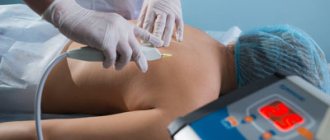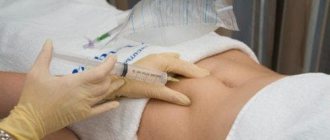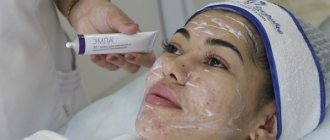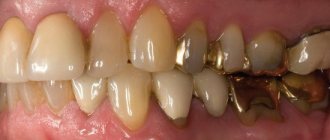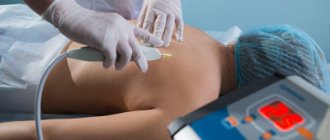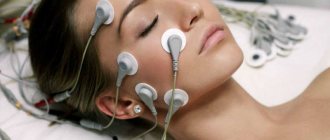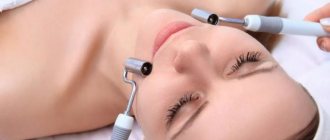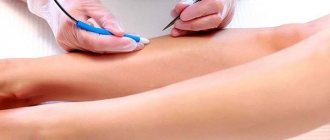Almost every patient who is admitted to the physiotherapy department for neurological complications of osteochondrosis, such as protrusion and hernia of the spine, is prescribed various options for electrotherapy. One of the most common and effective methods of using direct electric current is electrophoresis. Is it possible to do electrophoresis for herniated intervertebral discs? How does this treatment work? What are the possible contraindications, and with what drugs can this therapeutic effect be carried out?
Cervical hernia on MRI.
Mechanism of action of electrophoresis
Electrophoresis is one of the methods of percutaneous administration of drugs. Knowing the specific density and resistance of body tissues, the parameters of the electric current, and the physicochemical properties of the drug substance, it is possible to accurately determine the concentration of the drug at a given depth, including in paravertebral tissues. What kind of treatment method is this, and how does electrophoresis work?
Recall that the ordered movement of charged particles along a conductor is called electric current. The human body is a collection of conductors of the second kind, where there is no movement of free electrons, unlike metals. But in tissues there is movement of free ions in liquids charged both positively and negatively. Drug electrophoresis is based on this property.
If you place electrodes (cathode and anode) on the human body and induce a direct current, then a potential difference arises between the electrodes, and the movement of various ions in the underlying liquids between the electrodes occurs, both from “plus to minus” and vice versa. It is known that each cell contains up to 70% water, so even dense tissues can be considered permeable to direct current, with the exception of bone.
If a medicinal substance is placed on one of the electrodes, which dissociates into ions under the influence of current, then it begins to move into the tissue according to the potential difference. The movement of a drug that has broken up (dissociated) into ions in a solvent is described by simple rules:
- positively charged ions are repelled from the anode as ions of the same name (also a “positive” electrode);
- negatively charged drugs are repelled from the cathode (“negative” electrode).
Medicines move under the influence of Coulomb forces of electrostatic repulsion of like charges and attraction of opposite ones, which follow the direction of the current. Inside the skin, the medicine accumulates in the depths in the form of a depot, and from there it is slowly consumed in the tissues for up to 2 weeks. Electrophoresis not only allows the medicine to remain in the body for a long time, but also allows you to significantly increase their activity by placing them directly where they are needed, for example, to the deep back muscles. This means that even a small amount of the medicinal substance, about 5% of the amount applied to the electrodes, produces a pronounced therapeutic effect.
Indications for electrophoresis
The electrotherapy method is prescribed to newborns from 4 months of age, when there are indications for the procedure. For infants, procedures are necessary in the treatment of hip dysplasia and neurological pathologies. Electrophoresis allows you to deliver medicine to the child’s body without intravenous injections. Often, to increase the effect of treatment, electrophoresis is prescribed along with massage. Both procedures are absolutely painless and do not cause any discomfort to the baby.
Electrophoresis at home is more effective than in a medical institution, since the child does not receive stress. He does not need to be taken to a children's clinic, where there are many sick children. Devices for carrying out the procedure are freely available. Before purchasing equipment for electrophoresis, consult your doctor; he should prescribe special medications that can be used in ion therapy. Electrophoresis, like any treatment method, has contraindications. The local pediatrician must notify them. It is not recommended to perform endonasal electrophoresis at home, as this is a complex procedure that affects the nasal mucosa.
How does the device for electrophoresis work?
The standard technique for performing the electrophoresis procedure for protrusions or hernias is as follows. Stationary Amplipulse-5 (about 39 thousand rubles), or portable Potok (11 thousand rubles) devices, or more modern devices are used.
Any device is an alternating current rectifier, previously electron tube, currently semiconductor, with regulation of the current strength on the electrodes. Almost all devices operate from a standard alternating current network with a frequency of 50 Hz and a voltage of 220 V, are manufactured according to the second class of protection and, accordingly, do not require grounding devices. The device must be equipped with a milliammeter (either analog with an arrow, or digital in modern devices). There is a potentiometer, or rheostat, that allows you to slowly and smoothly regulate the current in the patient circuit between the electrodes. In older models, there is a separate shunt to the ammeter, which allows you to switch the limits of the measured current from 5 and 50 milliamps.
Apparatus.
In new models, the shunt is integrated into the microcircuit. The device is equipped with output terminals with mandatory polarity markings: “plus” - red and “minus” - white. The kit includes marked wires and a variety of electrodes that can be used as an anode, and in another circuit, as a cathode, since both electrodes are made of the same material. Electrodes are usually made of thin lead because they can bend and follow the curves of the body. Electrodes must be regularly cleaned of lead oxide as oxidized electrodes become less effective. Modern electrodes are made of special fabric impregnated with graphite. They are non-toxic, elastic, and conduct electricity well.
Diagnostics
To detect pelvic adhesions in women, use:
- Collection of general anamnesis and standard examination of the vagina;
- Ultrasound of the pelvic organs;
In rare cases, computed tomography may be used, which can allow visualization of adhesions in a place that is difficult to reach for other types of diagnostics. Doctors in our clinic conduct high-quality examinations. It is important for specialists to make the correct diagnosis and select the most effective treatment regimen.
Advantages and disadvantages
The general advantages of electrophoresis are as follows:
- the drug is administered actively and purposefully, since only those drugs that have an ionic form in solution are selected for electrophoresis, and the drug accumulates under the skin;
- the drug acts for a long time, has a therapeutic effect several days and even weeks after the end of the course;
- the medicine can be administered specifically, that is, paravertebrally or deep into the musculo-ligamentous apparatus of the spine, if we are talking about protrusions and hernias;
- An important point is the almost complete absence of adverse reactions, because the medicine does not pass through the gastrointestinal tract, liver, and does not irritate the gastric mucosa. Quite often, the drugs for electrophoresis that are used for protrusions or hernias will be nicotinic acid and aminophylline, and in the case of electrophoresis there is no need to be afraid of their usual side effects characteristic of oral use;
- electrophoresis differs favorably from injections in the method of drug delivery. After all, if there is a spasm of capillaries in the pathological focus, such as in chronic back pain due to the presence of a protrusion or hernia, then the injection often does not resolve for a long time. And the electric current is guaranteed to deliver medications evenly exactly where they are needed, bypassing the blood;
- electrophoresis helps to bring into the depths of the tissues only the medicine that is necessary: no impurities, ballast substances, which are contained in abundance in tablets, do not enter biological tissues during electrophoresis. In the same way, no associated solvent, without which various injections and intravenous infusions are impossible, is used. Therefore, the body is not loaded with excess fluid, microcirculation is not disrupted, and post-injection infiltrates and complications do not form;
- finally, electrophoresis is a completely painless, bloodless, and atraumatic method of drug administration, which is well tolerated by both adults and children.
Electrophoresis also has disadvantages. The most important of them is that not all drugs are suitable for this method of treatment, since not all of them disintegrate into ions, and having disintegrated, not all remain active in a dissociated state. Medicines that do not dissociate into ions are unsuitable for electrophoresis, that is, electrically neutral molecules. The second drawback is that a small electric current is not capable of creating fairly high concentrations of the drug, and it cannot be increased, otherwise the procedure will turn into an unpleasant and painful procedure. Finally, under the influence of electric current, many drugs change their activity, or even become useless, such as some anticoagulants.
Indications and contraindications
Electrophoresis is very similar to galvanization. Galvanization is different in that it applies direct current, but does not contain any medicine. Therefore, electrophoresis can also be called “medicinal galvanization.” Indications for electrophoresis will be:
- chronic inflammatory diseases of the musculoskeletal system (myositis, rheumatism, osteochondrosis and its complications);
- compression neurovascular syndromes;
- plexitis, neuritis and neuralgia;
- syndrome of acute pain in the neck (cervicago), chest and lower back - lumbago;
- chronic myofascial tonic syndrome, causing constant back pain.
Many of the above conditions are inevitable companions of discogenic exacerbations of osteochondrosis.
Electrophoresis is indicated in the initial stages of hypertension and coronary heart disease (with the exception of unstable angina). This method is used for pathologies of the lungs and bronchi, gastrointestinal tract, various gynecological and urological pathologies, diseases of the ENT organs and in many other cases.
General contraindications to electrophoresis include any tumor growth, both malignant and benign, active tuberculosis, suppuration, streptoderma, erysipelas at the sites where electrodes are applied and bleeding wounds, disorders of the integrity of the skin such as eczema and psoriasis, skin mycoses .
Special contraindications include intolerance to exposure to electric current, foreign metal prostheses in the intended area of influence, severe cardiovascular insufficiency, and heart rhythm disturbances.
What to do if the doctor does not prescribe enzyme preparations for pelvic inflammation?
For inflammatory diseases, doctors prescribe antibiotics that attack the cause of the disease - the infectious agent. But we must not forget that the presence of inflammation in the abdominal cavity and in the internal genital organs of a woman creates conditions for triggering the mechanisms of the adhesive process already from the third day of the disease. If the doctor has not prescribed a remedy for the prevention and treatment of adhesions, you should ask at what stage he plans to include this therapy. It is important not to waste time, because adhesions are more successfully treated at the stage of “tender adhesions” rather than “dense connective tissue cords”.
Photo: macniak/freepik.com
- (De Wilde RL, Trew G. Postoperative abdominal adhesions and their prevention in gynecological surgery. Expert consensus position. Gynecol Surg 2007;4:161-8).
- (Dubrovina S.O. Monograph “Adhesive process” Rostov-on-Don 2015).
- “Some modern aspects of inflammatory diseases of the pelvic organs” Consilium Medicum 2015, Volume 17, No. 6.
- (Fedorovich O.K., Matveev A.M., Pomortsev A.V. “The effectiveness of the use of anti-adhesive agents and Longidase in maintaining the patency of the fallopian tubes after treatment of an uninterrupted tubal pregnancy.” Russian Bulletin of Obstetrician-Gynecologist 2014; 6: 91 - 93) .
- (Strizhakov A.N., Pirogova M.N., Shakhlamova M.N. “Prevention and treatment of adhesions after surgical treatment of ovarian apoplexy” Russian Bulletin of Obstetrician-Gynecologist, 2015; 2: 36-42.
Is it possible to do electrophoresis for a herniated disc?
The therapeutic effect of electrophoresis consists of two factors:
- direct influence of electric current, that is, galvanization;
- additional effect of the administered drug.
The therapeutic effect of direct current is to shift the ratio of ions in tissues. The receptors are irritated, local and even general reflex reactions occur. The permeability of cell membranes changes, blood vessels dilate, blood circulation and lymph flow increase. Soft tissues are better supplied with blood and regenerate, and the resorption of inflammatory infiltrates is enhanced. These changes have a beneficial effect on foci of chronic inflammation, which often cause persistent pain in various parts of the spine in the presence of protrusions and hernias.
The effect of a drug depends on its ability to dissociate, that is, break down into ions. And most often for complications of osteochondrosis, the following medications are used:
- novocaine (+);
- aminophylline (-);
- lidase (+);
- analgin (-);
- pyridoxine (vitamin B6, +);
- thiamine (vitamin B1,+);
- cyanocobalamin (vitamin B12,+).
For each medicinal substance, it is indicated in parentheses on which electrode it should be applied, and accordingly, it is this electrode that should be adjacent to the corresponding part of the spine. After all, the medicinal substance is repelled from the electrode, being similarly charged. An electrode of opposite polarity should be located on a different surface of the body, or at a considerable distance, but on the same surface, to create a skin depot.
You should know that many medications require preliminary preparation, so Lidase is taken in an amount of 64 units and diluted in distilled water, which is acidified with a weak solution of hydrochloric acid so that the final pH of the solution is from 5 to 5.2.
How is the session conducted?
Before starting work, prepare the device by changing the limit value of the ammeter depending on the current strength prescribed by the doctor. Electrodes with pads moistened with the appropriate preparation are applied and secured to the patient. It is strictly forbidden to apply electrodes directly to the body, since as a result of chemical reactions, either an acidic or an alkaline environment can form under the electrode and cause a chemical burn. Between the electrode and the body there must be a pad of calico or flannel, at least 5 mm thick, moistened with water. This kind of gasket reduces skin resistance, helps eliminate the effect of electrolysis on the skin, and makes the penetration of the medicinal substance more uniform. The electrodes are connected to the wires with terminals, the wires are connected to the “output” of the device, observing the polarity, and the device is connected to the network.
Application of electrodes
It is extremely important to place the electrodes correctly. For cervical osteochondrosis, a galvanic collar can be used, when one of the collar-shaped electrodes is located on the back, neck and shoulder girdle, and the second in the lumbar region. Accordingly, if a doctor prescribes a drug with a positively charged sign, then an anode should be placed on the shoulders so that the medicinal substance is repelled from it and penetrates deep into the skin. If a medicinal substance with the opposite sign is prescribed for electrophoresis, then this electrode should be the cathode. The standard current strength for cervical osteochondrosis is from 6 to 15 milliamps, and the session duration is from 5 to 15 minutes. Procedures can be performed daily or every other day; the course consists of an average of 15 procedures. After each procedure, the time gradually increases by 2 minutes, and the current strength is increased by 2 milliamps. In the case of lumbosacral osteochondrosis, one of the electrodes is applied to the lumbosacral region, and two paired electrodes of opposite polarity can be located on the anterior surfaces of the thighs. The current strength is also up to 15 milliamps, the duration of one session is up to 20 minutes, the duration of the course is up to 20 procedures, either daily or every other day. When conducting electrophoresis for protrusions and hernias in the thoracic region, special techniques for applying electrodes are also used.
After the signal light comes on, the required current strength is set using a potentiometer, depending on the readings of the device. It is important that the current strength at the very beginning needs to be set less than necessary, since then the current will spontaneously increase somewhat, since the skin resistance under the electrodes will decrease. After 3-4 minutes, the current strength is finally adjusted taking into account the patient’s sensations. There should be no burning sensation, unpleasant sensation, or feeling of “goosebumps” under the electrodes.
After the required time has passed, the current strength is gradually reduced to 0, and only then the electrodes and pads are removed from the patient.
During the procedure, the patient may feel a slight tingling or warmth under the electrodes, but without pain or discomfort. If a strong burning sensation or severe pain occurs, it is necessary to reduce the current strength or stop the procedure.
How does Longidaza work in different situations?
The acute phase of the onset of diseases of the pelvic organs such as endometritis, adnexitis and salpingitis cannot be missed in the everyday bustle. From the first days, the temperature rises, unpleasant discharge appears, and sharp pains in the lower abdomen make you forget about everything in the world. Most often the cause of this is pathogenic bacteria. But not everyone knows that already at this moment the body itself starts the process of proliferation of connective tissue around the source of inflammation, blocking the source of infection. To avoid the formation of adhesions, doctors, along with antibacterial drugs, prescribe the enzyme drug Longidaza, which prevents the development of adhesions, prevents the development of infertility and preserves a woman’s reproductive health.^(4)
Photo: atlascompany / freepik.com
Much more insidious are chronic, sluggish inflammatory processes that go unnoticed for years, causing serious damage to the organs of the woman’s reproductive system. In chronic inflammation, adhesions have already formed, which means that because of them, drug therapy reaches the site of inflammation with great difficulty. In this case, it is not enough to prevent the development of new adhesions; it is necessary to influence existing ones in order to increase the access of antibacterial drugs to the source of infection. Longidaza reduces swelling of inflamed tissues, increases the elasticity of formed adhesions and prevents the formation of new ones, as a result of which the adhesive process is reduced.^(5)
In cases of gynecological operations, injuries and abortions, adhesions are formed in the same way as in acute inflammation - from the third day of the disease. The inclusion of Longidase in complex treatment not only reduces the adhesive process, but also improves the body's resistance to infections, and also ensures rapid recovery after surgery, due to increased immunity of the woman.^(5)
